An Arch-Bridge Topology-Based Expressway Network Structure and Automatic Generation
Abstract
1. Introduction
- (1)
- We proposed a novel arch-bridge topology structure with ETC gantries as key nodes, which can simplify the complex road network topology to the smallest unit by redefining the topology of expressways.
- (2)
- Through deep mining and the analysis of ETC data characteristics, we designed excellent optimization rules for targeted anomalous topologies such as loop, reverse, missing, and opposite topologies.
- (3)
- The validity of the proposed method is verified by using real ETC transaction data with a user penetration rate of over 80%, which can achieve the effective and cost-effective generation of the entire domain of an expressway road network topology.
2. Literature Review
2.1. Remote Sensing Image Recognition Method
2.2. Spatio-Temporal Trajectory Mining
3. Methodology
3.1. Arch-Bridge Topology
- (1)
- is a directed graph, with the starting node , the middle node , and the ending node ;
- (2)
- There are pairs of paths: and .
3.2. Automatic Generation of Expressway Network Topology
3.2.1. Topology Set Generation and Analysis
- (1)
- Generally, data is repeatedly uploaded during transmission or copied repeatedly during storage, which easily leads to an increase in data size and causes serious interference to the automatic generation of ETC topology. In addition, when traffic congestion, breakdowns, and other issues occur within the ETC gantry antenna coverage area, the vehicle-mounted OBU will continue to communicate with the ETC antenna, resulting in duplicate data collection. As shown in Figure 4a, abnormal topology forms a loop, referred to as a loop topology.
- (2)
- Due to equipment failures, severe weather conditions, etc., the vehicle-mounted device and the ETC antenna may not communicate or fail to communicate successfully, resulting in data loss. At the same time, packet loss may occur during data transmission, causing data loss. When n ≥ 3, there may be consecutive data loss, referred to as a missing topology, as shown in Figure 4b.
- (3)
- Due to wireless interference, the vehicle-mounted OBU driving on the road upline (downline) successfully communicates with the ETC antenna deployed on the road downline (upline), and the resulting topology is referred to as opposite topology record data that do not conform to the rules of expressway driving, as shown in Figure 4c.
- (4)
- Special vehicles such as police cars and emergency vehicles inevitably perform reverse driving when executing emergency or special tasks, resulting in and referred to as a reverse topology, as shown in Figure 4d.
3.2.2. Candidate Topology Set Optimization
- (a)
- Loop Topology Optimization
- (b)
- Reverse Topology Optimization
- (1)
- : From the gantry nodes on the road section to the gantry entrance nodes or province entrance gantry;
- (2)
- : From the exit gantry nodes or province exit gantry nodes to the normal gantry nodes on the road section;
- (3)
- : From normal gantry nodes on the road section to normal gantry nodes on the road section.
- (c)
- Missing Topology Optimization
- Step 1: Calculate the distances for all candidate edge sets cE, and construct an expressway network distance-weighted graph ;
- Step 2: Set the starting point o and the ending point d, mark the starting point, and set all other nodes as unmarked. Let k = o, , , and p = [] be the predecessor array;
- Step 3: Search for the node j directly connected to node k in the set of all unmarked nodes and calculate and update as follows:
- Step 4: Obtain the node in the set J of all unmarked nodes that is closest to the starting point o:
- Step 5: Mark . If all nodes have been marked, the method exits; otherwise, update k = and go to Step 3.
- (d)
- Opposite Topology Optimization
- (1)
- or : erroneous transactions with the bidirectional gantry itself;
- (2)
- or : erroneous transactions with the bidirectional gantry of the next gantry , directly connected in the same direction as ;
- (3)
- or : erroneous transactions with the opposite gantry of the nth (n ≥ 2) gantry in the same direction as the gantry .
4. Experiment and Results Analysis
4.1. Data Description
4.2. Road Network Topology Coverage
4.3. Evaluation of Road Network Topology Reconstruction
4.4. Efficiency
5. Conclusions
Author Contributions
Funding
Institutional Review Board Statement
Informed Consent Statement
Data Availability Statement
Conflicts of Interest
References
- Ministry of Transport of the Peoples’s Republic of China. 2021 Statistical Bulletin on the Development of the Transportation Industry; Ministry of Transport of the People’s Republic of China: Beijing, China, 2021.
- Qian, C.; Li, S.-y.; Wang, Y.-f. Rationalized Lanes Configuration for Expressway Gantry Plaza. J. Transp. Syst. Eng. Inf. Technol. 2021, 21, 231–237. [Google Scholar]
- Chiou, J.M.; Lion, H.T.; Chen, W.H. Modeling Time-Varying Variability and Reliability of Freeway Travel Time Using Functional Principal Component Analysis. IEEE Trans. Intell. Transp. Syst. 2021, 99, 1–10. [Google Scholar] [CrossRef]
- Chen, L.W.; Chen, D.E. Exploring Spatiotemporal Mobilities of Expressway Traffic Flows for Precise Travel Time Estimation and Prediction Based on Electronic Gantry Collection Data. Veh. Commun. 2021, 30, 100356. [Google Scholar]
- Luo, S.; Zou, F.; Zhang, C.; Tian, J.; Guo, F.; Liao, L. Multi-View Travel Time Prediction Based on Electronic Gantry Collection Data. Entropy 2022, 24, 1050. [Google Scholar] [CrossRef] [PubMed]
- Yao, E.; Wang, X.; Yang, Y.; Pan, L.; Song, Y. Traffic Flow Estimation Based on Gantry Ticket Data Considering Multitype Vehicle Impact. J. Transp. Eng. Part Syst. 2021, 147, 04020158. [Google Scholar] [CrossRef]
- Cai, Q.; Yi, D.; Zou, F.; Zhou, Z.; Li, N.; Guo, F. Recognition of Vehicles Entering Expressway Service Areas and Estimation of Dwell Time Using ETC Data. Entropy 2022, 24, 1208. [Google Scholar] [CrossRef]
- Zou, F.; Ren, Q.; Tian, J.; Guo, F.; Huang, S.; Liao, L.; Wu, J. Expressway speed prediction based on electronic toll collection data. Electronics 2022, 11, 1613. [Google Scholar] [CrossRef]
- Wang, H.; Zou, F.; Tian, J.; Guo, F.; Cai, Q. Analysis on Lane Capacity for Expressway Toll Station Using Toll Data. J. Adv. Transp. 2022, 2022, 9277000. [Google Scholar] [CrossRef]
- Tsung, C.K.; Yang, C.T.; Yang, S.W. Visualizing Potential Transportation Demand from ETC Log Analysis Using ELK Stack. IEEE Internet Things J. 2020, 7, 6623–6633. [Google Scholar] [CrossRef]
- Zou, F.; Guo, F.; Tian, J.; Luo, S.; Yu, X.; Gu, Q.; Liao, L. The Method of Dynamic Identify the Maximum Speed Limit of Expressway Based on Electronic Gantry Collection Data. Sci. Program. 2021, 2021, 4702669. [Google Scholar]
- Guo, F.; Zou, F.; Luo, S.; Chen, H.; Yu, X.; Zhang, C.; Liao, L. Positioning method of expressway ETC gantry by multi-source traffic data. IET Intell. Transp. Syst. 2022, 1–15. [Google Scholar] [CrossRef]
- Guo, F.; Zou, F.; Luo, S.; Liao, L.; Wu, J.; Yu, X.; Zhang, C. The Fast Detection of Abnormal ETC Data Based on an Improved DTW Algorithm. Electronics 2022, 11, 1981. [Google Scholar] [CrossRef]
- Zhu, L.; Wen, H. Automatic incremental identification and technology update of traffic road network data. Traffic Inf. Saf. 2009, 27, 22–24+55. [Google Scholar]
- Zhang, S.; Guan, G.; Zou, F.; Zhu, D. Automatic detection of additional roads by combining floating vehicle and spatial grid. Sci. Technol. Eng. 2012, 12, 5496–5501. [Google Scholar]
- Lian, R.; Wang, W.; Mustafa, N.; Huang, L. Road extraction methods in high-resolution remote sensing images: A comprehensive review. IEEE J. Sel. Top. Appl. Earth Obs. Remote Sens. 2020, 13, 5489–5507. [Google Scholar] [CrossRef]
- Kass, M.; Witkin, A.; Terzopoulos, D. Snakes: Active contour models. Int. J. Comput. Vis. 1988, 1, 321–331. [Google Scholar] [CrossRef]
- Péteri, R.; Ranchin, T. Multiresolution Snakes for Urban Road Extraction from Ikonos and Quickbird Images; Remote Sensing in Transition: Ghent, Belgium, 2003; pp. 141–147. [Google Scholar]
- Laptev, I.; Mayer, H.; Lindeberg, T.; Eckstein, W.; Steger, C. Automatic extraction of roads from aerial images based on scale space and snakes. Mach. Vis. Appl. 2000, 12, 23–31. [Google Scholar] [CrossRef]
- Trinder, J.C.; Wang, Y. Automatic road extraction from aerial images. Digit. Signal Process. 1998, 8, 215–224. [Google Scholar] [CrossRef]
- Dal Poz, A.P.; Gyftakis, S.; Agouris, P. Semiautomatic road extraction: Comparison of methodologies and experiments. In Proceedings of the 2000 ASPRS Annual Conference, Washington, DC, USA, 21–26 May 2000. [Google Scholar]
- Gruen, A.; Li, H. Road extraction from aerial and satellite images by dynamic programming. ISPRS J. Photogramm. Remote Sens. 1995, 50, 11–20. [Google Scholar] [CrossRef]
- Dal Poz, A.P.; Do Vale, G.M. Dynamic programming approach for semi-automated road extraction from medium-and high-resolution images. ISPrS Arch. 2003, 34, W8. [Google Scholar]
- Wegner, J.D.; Montoya-Zegarra, J.A.; Schindler, K. Road networks as collections of minimum cost paths. ISPRS J. Photogramm. Remote Sens. 2015, 108, 128–137. [Google Scholar] [CrossRef]
- Mokhtarzade, M.; Zoej, M.J.V. Road detection from high-resolution satellite images using artificial neural networks. Int. J. Appl. Earth Obs. Geoinf. 2007, 9, 32–40. [Google Scholar] [CrossRef]
- Kirthika, A.; Mookambiga, A. Automated road network extraction using artificial neural network. In Proceedings of the 2011 International Conference on Recent Trends in Information Technology (ICRTIT), Chennai, India, 3–5 June 2011; pp. 1061–1065. [Google Scholar]
- Mountrakis, G.; Im, J.; Ogole, C. Support vector machines in remote sensing: A review. ISPRS J. Photogramm. Remote Sens. 2011, 66, 247–259. [Google Scholar] [CrossRef]
- Yager, N.; Sowmya, A. Support vector machines for road extraction from remotely sensed images. In Proceedings of the International Conference on Computer Analysis of Images and Patterns, Groningen, The Netherlands, 25–27 August 2003; Springer: Berlin/Heidelberg, Germany, 2003; pp. 285–292. [Google Scholar]
- Mirnalinee, T.T.; Das, S.; Varghese, K. An integrated multistage framework for automatic road extraction from high resolution satellite imagery. J. Indian Soc. Remote Sens. 2011, 39, 1–25. [Google Scholar] [CrossRef]
- Mnih, V.; Hinton, G.E. Learning to detect roads in high-resolution aerial images. In Proceedings of the European Conference on Computer Vision, Crete, Greece, 5–11 September 2010; Springer: Berlin/Heidelberg, Germany, 2010; pp. 210–223. [Google Scholar]
- Saito, S.; Yamashita, T.; Aoki, Y. Multiple object extraction from aerial imagery with convolutional neural networks. Electron. Imaging 2016, 2016, 1–9. [Google Scholar] [CrossRef]
- Ronneberger, O.; Fischer, P.; Brox, T. U-net: Convolutional networks for biomedical image segmentation. In Proceedings of the International Conference on Medical Image Computing and Computer-Assisted Intervention, Munich, Germany, 5–9 October 2015; Springer: Cham, Switzerland, 2015; pp. 234–241. [Google Scholar]
- Du, G.; Cao, X.; Liang, J.; Chen, X.; Zhan, Y. Medical image segmentation based on u-net: A review. J. Imaging Sci. Technol. 2020, 64, 1–12. [Google Scholar] [CrossRef]
- Diakogiannis, F.I.; Waldner, F.; Caccetta, P.; Wu, C. ResUNet-a: A deep learning framework for semantic segmentation of remotely sensed data. ISPRS J. Photogramm. Remote Sens. 2020, 162, 94–114. [Google Scholar] [CrossRef]
- Sultonov, F.; Park, J.H.; Yun, S.; Lim, D.W.; Kang, J.M. Mixer U-Net: An Improved Automatic Road Extraction from UAV Imagery. Appl. Sci. 2022, 12, 1953. [Google Scholar] [CrossRef]
- Wagstaff, K.; Cardie, C.; Rogers, S.; Schrödl, S. Constrained k-means clustering with background knowledge. In Proceedings of the Eighteenth International Conference on Machine Learning, Virtual, 18–24 August 2001; Volume 1, pp. 577–584. [Google Scholar]
- Schroedl, S.; Wagstaff, K.; Rogers, S.; Langley, P.; Wilson, C. Mining GPS traces for map refinement. Data Min. Knowl. Discov. 2004, 9, 59–87. [Google Scholar] [CrossRef]
- Edelkamp, S.; Schrödl, S. Route planning and map inference with global positioning traces. In Computer Science in Perspective; Springer: Berlin/Heidelberg, Germany, 2003; pp. 128–151. [Google Scholar]
- Worrall, S.; Nebot, E. Automated process for generating digitised maps through GPS data compression. In Proceedings of the Australasian Conference on Robotics and Automation, Brisbane, Australia, 10–12 December 2007; ACRA: Brisbane, Australia, 2007; Volume 6. [Google Scholar]
- Chen, C.; Lu, C.; Huang, Q.; Yang, Q.; Gunopulos, D.; Guibas, L. City-scale map creation and updating using GPS collections. In Proceedings of the 22nd ACM SIGKDD International Conference on Knowledge Discovery and Data Mining, San Francisco, CA, USA, 13–17 August 2016; pp. 1465–1474. [Google Scholar]
- Sasaki, Y.; Yu, J.; Ishikawa, Y. Road segment interpolation for incomplete road data. In Proceedings of the 2019 IEEE International Conference on Big Data and Smart Computing (BigComp), Kyoto, Japan, 27 February–2 March 2017; pp. 1–8. [Google Scholar]
- Huang, J.; Zhang, Y.; Deng, M.; He, Z. Mining crowdsourced trajectory and geo-tagged data for spatial-semantic road map construction. Trans. GIS 2022, 26, 735–754. [Google Scholar] [CrossRef]
- Silverman, B.W. Density Estimation for Statistics and Data Analysis; Routledge: Oxfordshire, UK, 2018. [Google Scholar]
- Uduwaragoda, E.; Perera, A.S.; Dias, S.A.D. Generating lane level road data from vehicle trajectories using kernel density estimation. In Proceedings of the 16th International IEEE Conference on Intelligent Transportation Systems (ITSC 2013), The Hague, The Netherlands, 6–9 October 2013; pp. 384–391. [Google Scholar]
- Kuntzsch, C.; Sester, M.; Brenner, C. Generative models for road network reconstruction. Int. J. Geogr. Inf. Sci. 2016, 30, 1012–1039. [Google Scholar] [CrossRef]
- Neuhold, R.; Haberl, M.; Fellendorf, M.; Pucher, G.; Dolancic, M.; Rudigier, M.; Pfister, J. Generating a lane-specific transportation network based on floating-car data. In Advances in Human Aspects of Transportation; Springer: Cham, Switzerland, 2017; pp. 1025–1037. [Google Scholar]
- Fu, Z.; Fan, L.; Sun, Y.; Tian, Z. Density adaptive approach for generating road network from GPS trajectories. IEEE Access 2020, 8, 51388–51399. [Google Scholar] [CrossRef]
- Fathi, A.; Krumm, J. Detecting road intersections from GPS traces. In Proceedings of the International Conference on Geographic Information Science, Zurich, Switzerland, 14–17 September 2010; Springer: Berlin/Heidelberg, Germany, 2010; pp. 56–69. [Google Scholar]
- Karagiorgou, S.; Pfoser, D. On vehicle tracking data-based road network generation. In Proceedings of the 20th International Conference on Advances in Geographic Information Systems, Redondo Beach, CA, USA, 6–9 November 2012; pp. 89–98. [Google Scholar]
- Xingzhe, X.; Liao, W.; Aghajan, H.; Veelaert, P.; Philips, W. Detecting road intersections from GPS traces using longest common subsequence algorithm. ISPRS Int. J. Geo Inf. 2016, 6, 1. [Google Scholar]
- Xie, X.; Philips, W. Road intersection detection through finding common sub-tracks between pairwise GNSS traces. ISPRS Int. J. Geo Inf. 2017, 6, 311. [Google Scholar] [CrossRef]
- Wu, J.; Zhu, Y.; Ku, T.; Wang, L. Detecting Road Intersections from Coarse-gained GPS Traces Based on Clustering. J. Comput. 2013, 8, 2959–2965. [Google Scholar] [CrossRef]
- Huang, Y.; Xiao, Z.; Yu, X.; Wang, D.; Havyarimana, V.; Bai, J. Road network construction with complex intersections based on sparsely sampled private car trajectory data. ACM Trans. Knowl. Discov. Data 2019, 13, 1–28. [Google Scholar] [CrossRef]
- Deng, M.; Huang, J.; Zhang, Y.; Liu, H.; Tang, L.; Tang, J.; Yang, X. Generating urban road intersection models from low-frequency GPS trajectory data. Int. J. Geogr. Inf. Sci. 2018, 32, 2337–2361. [Google Scholar] [CrossRef]
- Pu, M.; Mao, J.; Du, Y.; Shen, Y.; Jin, C. Road intersection detection based on direction ratio statistics analysis. In Proceedings of the 2019 20th IEEE International Conference on Mobile Data Management (MDM), Hong Kong, China, 10–13 June 2019; pp. 288–297. [Google Scholar]
- Zhao, L.; Mao, J.; Pu, M.; Liu, G.; Jin, C.; Qian, W.; Zhou, A.; Wen, X.; Hu, R.; Chai, H. Automatic calibration of road intersection topology using trajectories. In Proceedings of the 2020 IEEE 36th International Conference on Data Engineering (ICDE), Dallas, TX, USA, 20–24 April 2020; pp. 1633–1644. [Google Scholar]
- Qing, R.; Liu, Y.; Zhao, Y.; Liao, Z.; Liu, Y. Using Feature Interaction among GPS Data for Road Intersection Detection. In Proceedings of the 2nd International Workshop on Human-centric Multimedia Analysis, Virtual, 20–24 October 2021; pp. 31–37. [Google Scholar]
- Liu, Y.; Qing, R.; Zhao, Y.; Liao, Z. Road Intersection Recognition via Combining Classification Model and Clustering Algorithm Based on GPS Data. ISPRS Int. J. Geo Inf. 2022, 11, 487. [Google Scholar] [CrossRef]
- Ministry of Transport of the Peoples’s Republic of China. ETC Gantry System Technical Requirements for Expressways; Ministry of Transport of the People’s Republic of China: Beijing, China, 2019.
- Dijkstra, E.W. A note on two problems in connexion with graphs. Numer. Math. 1959, 1, 269–271. [Google Scholar] [CrossRef]
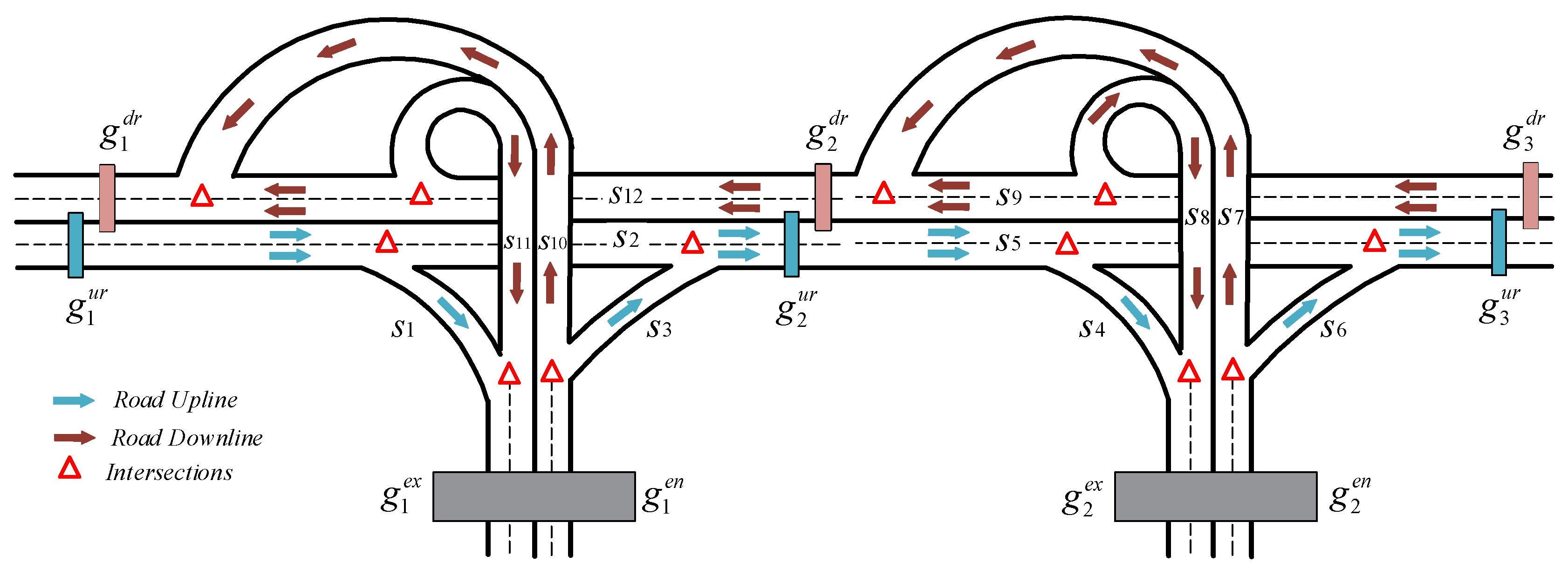
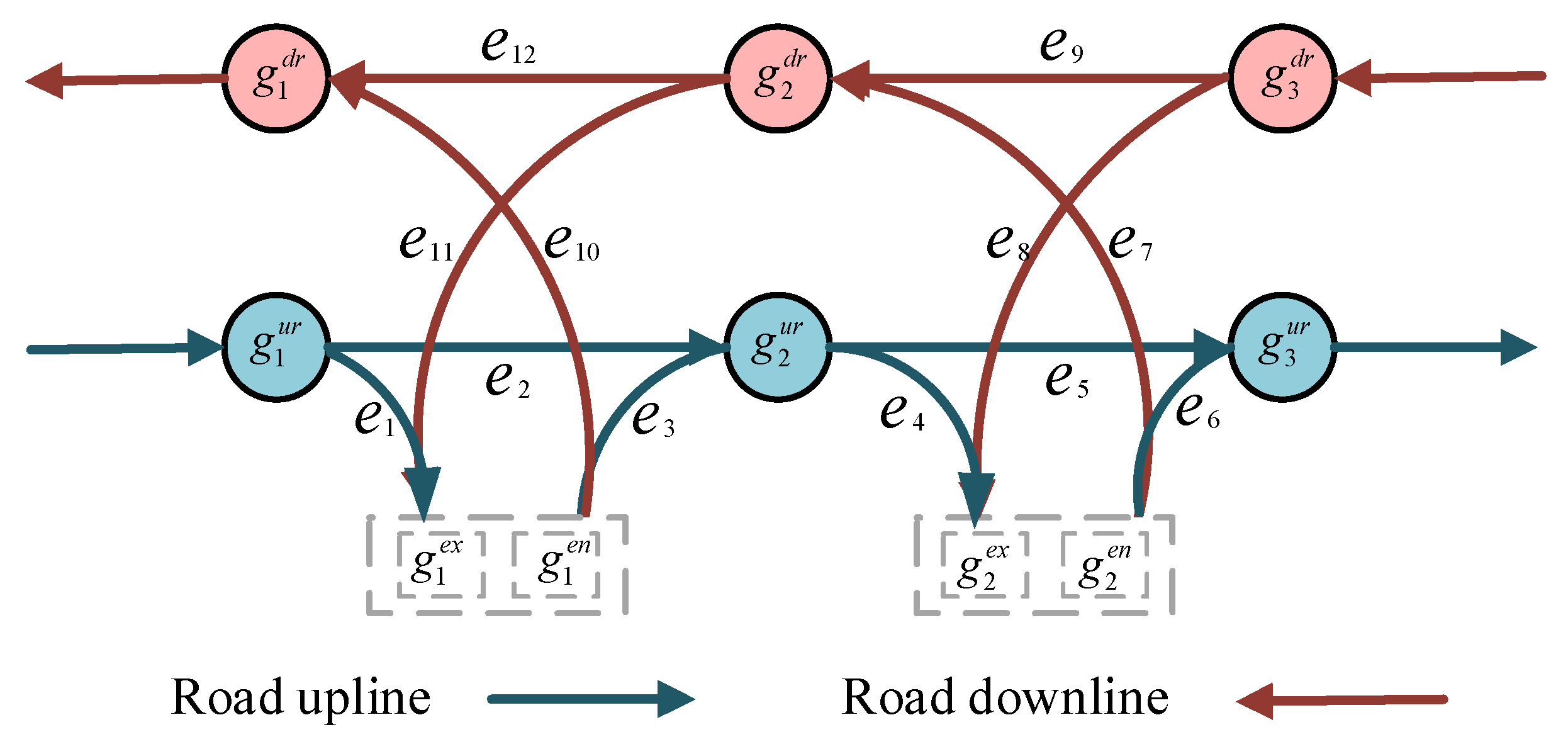
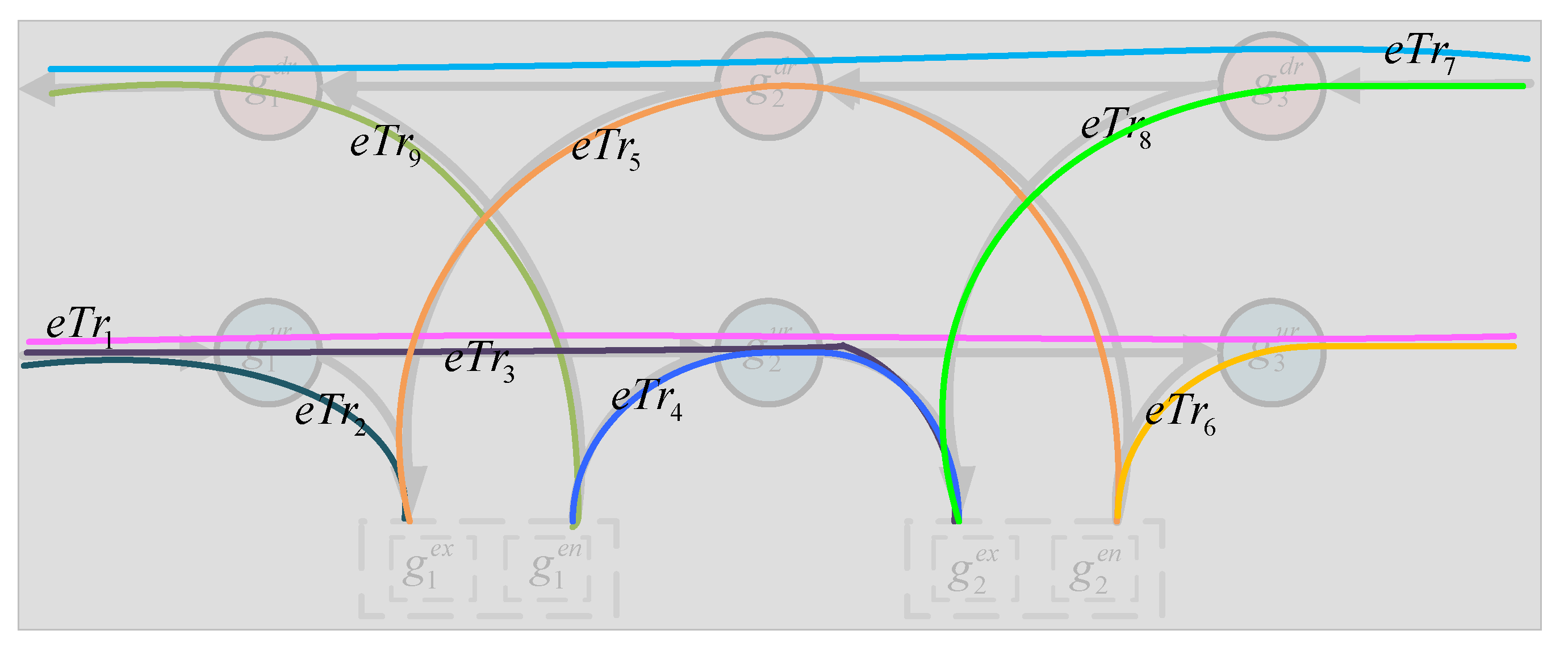
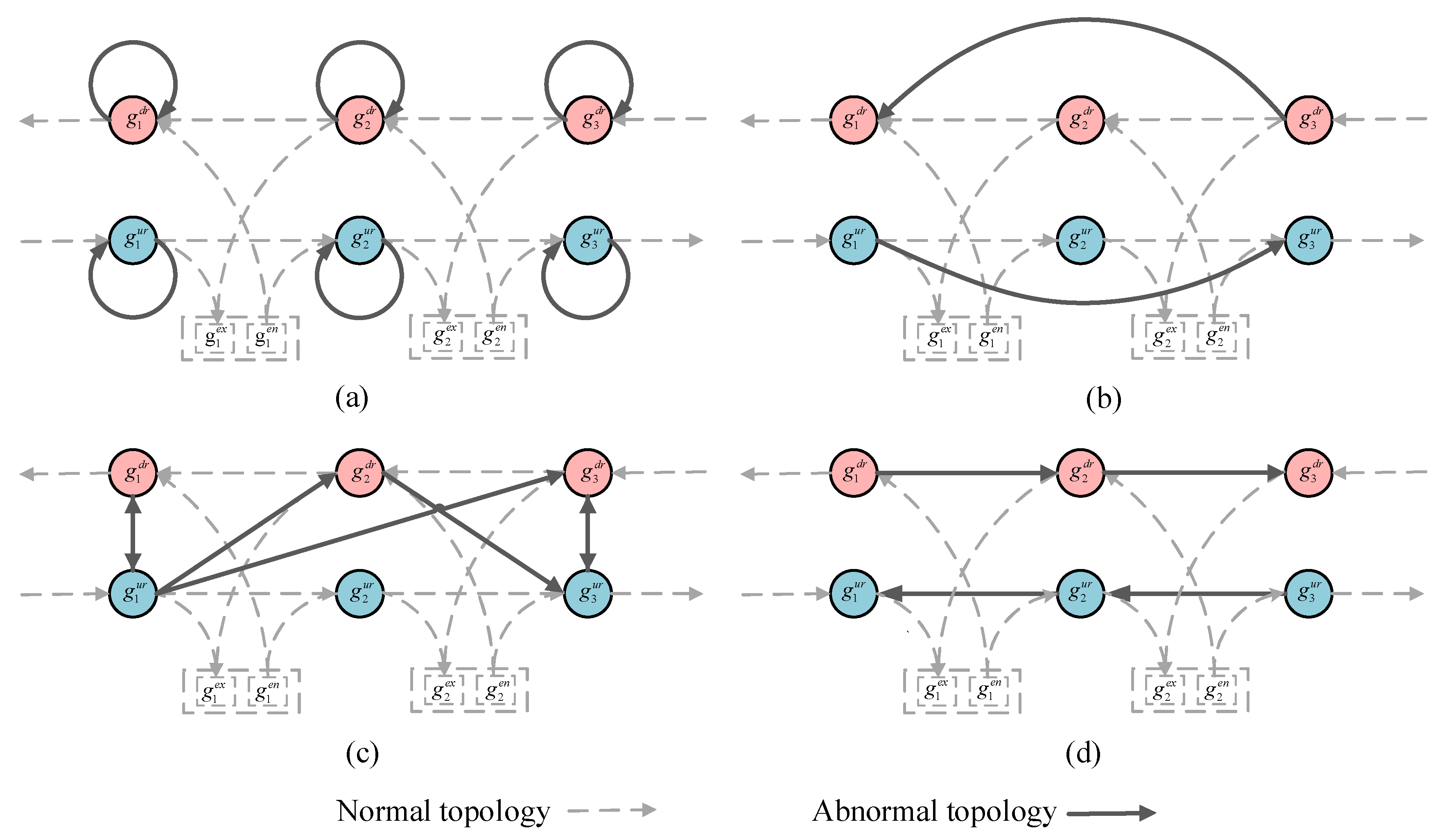
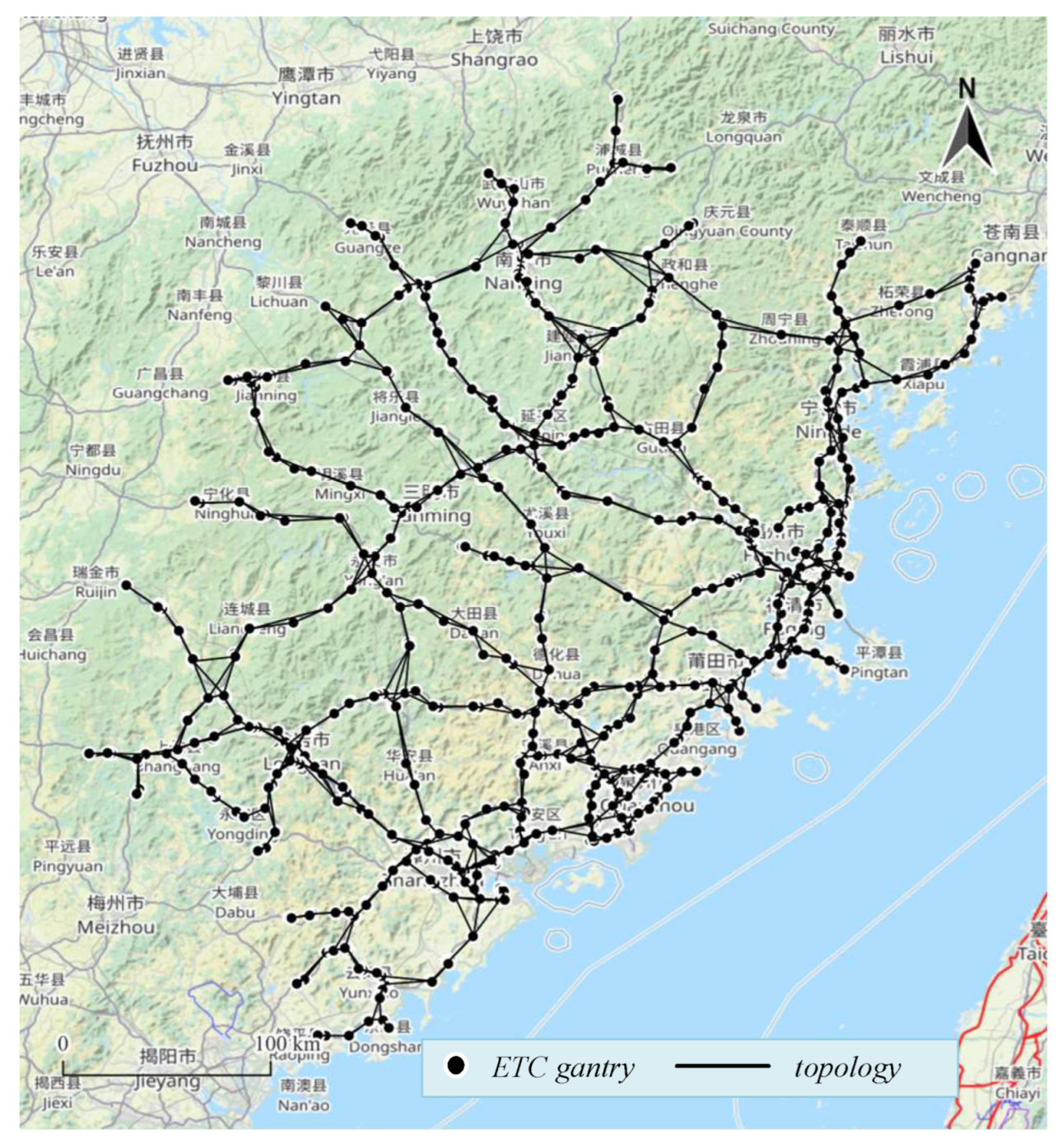
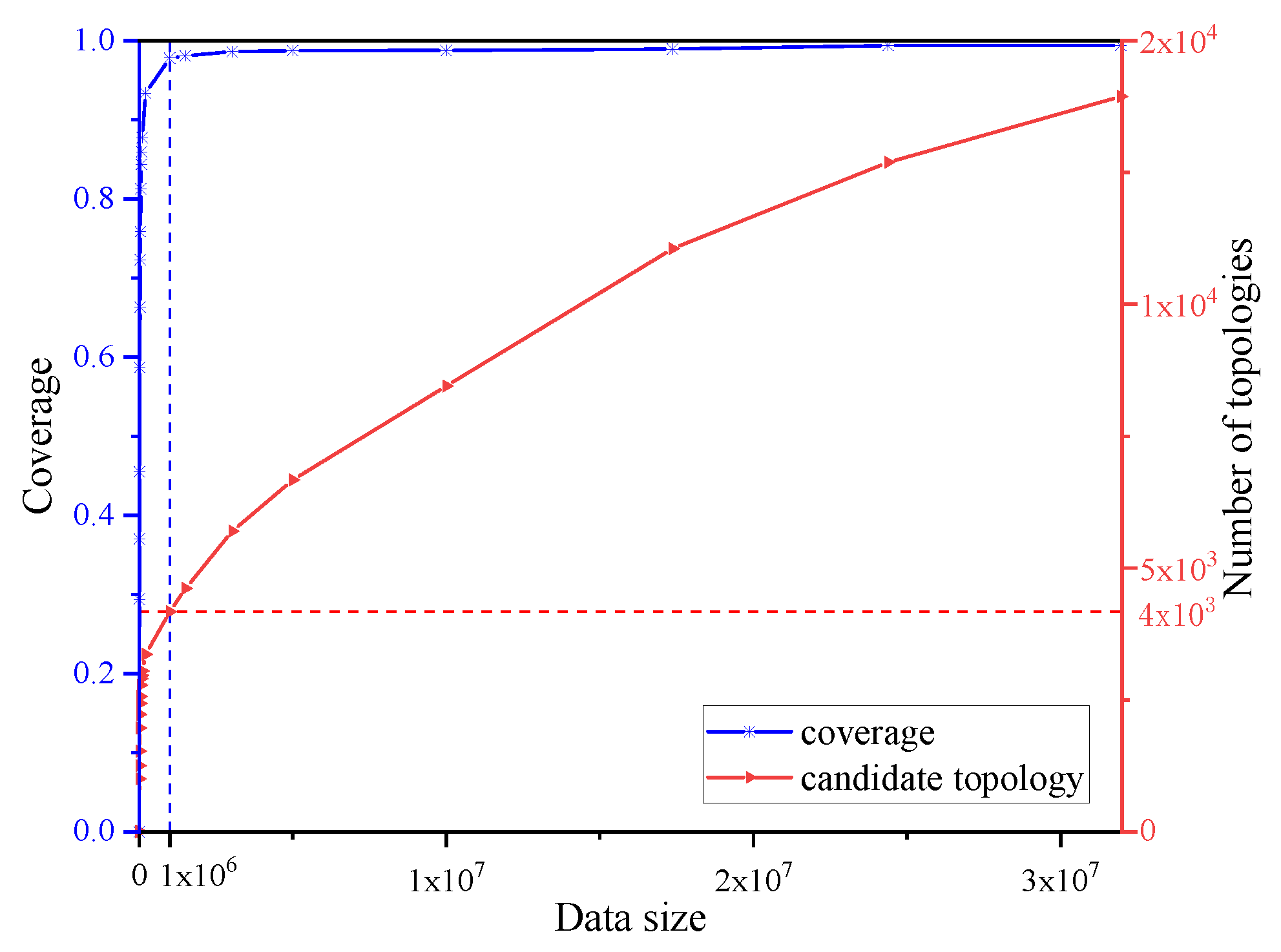
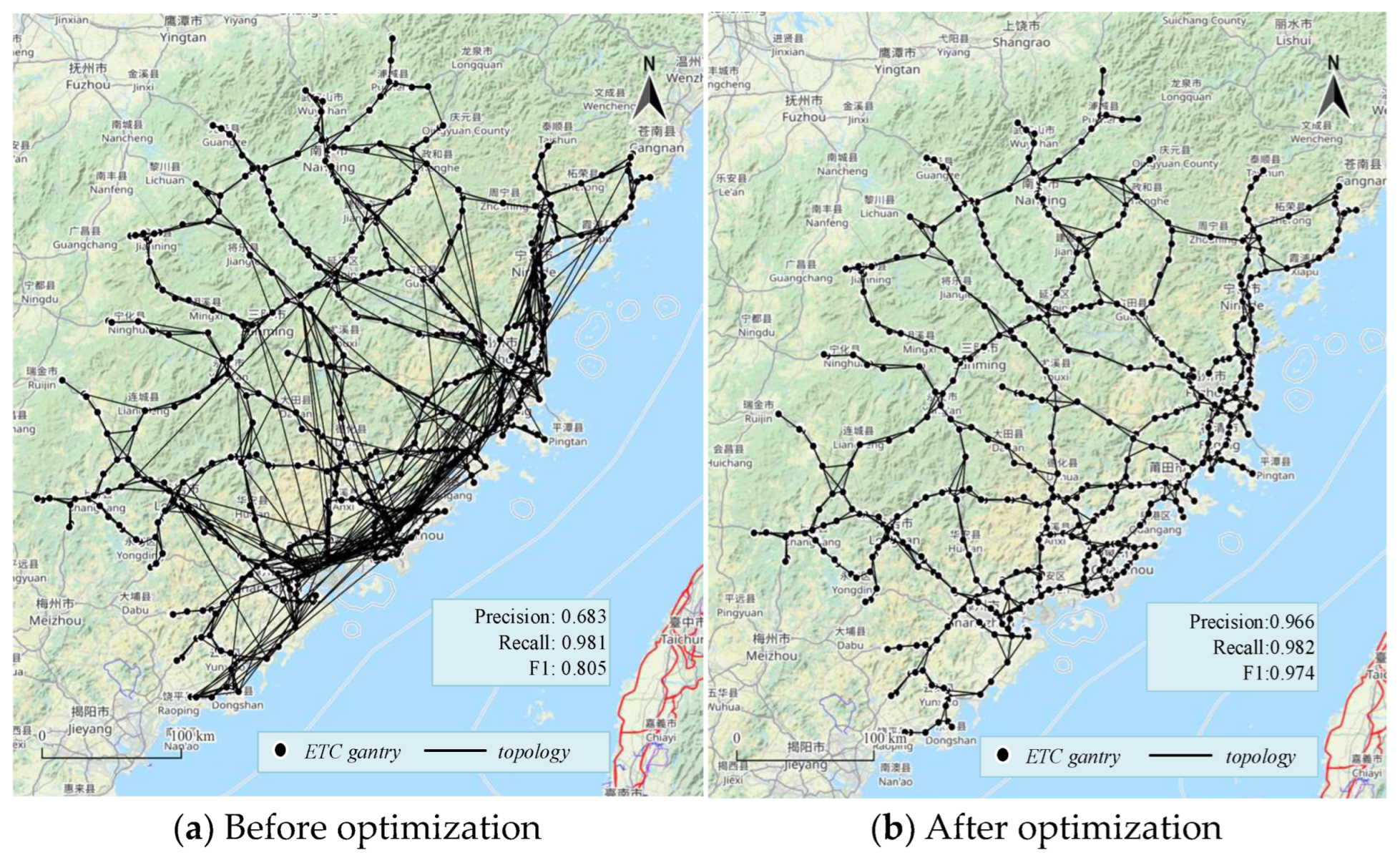
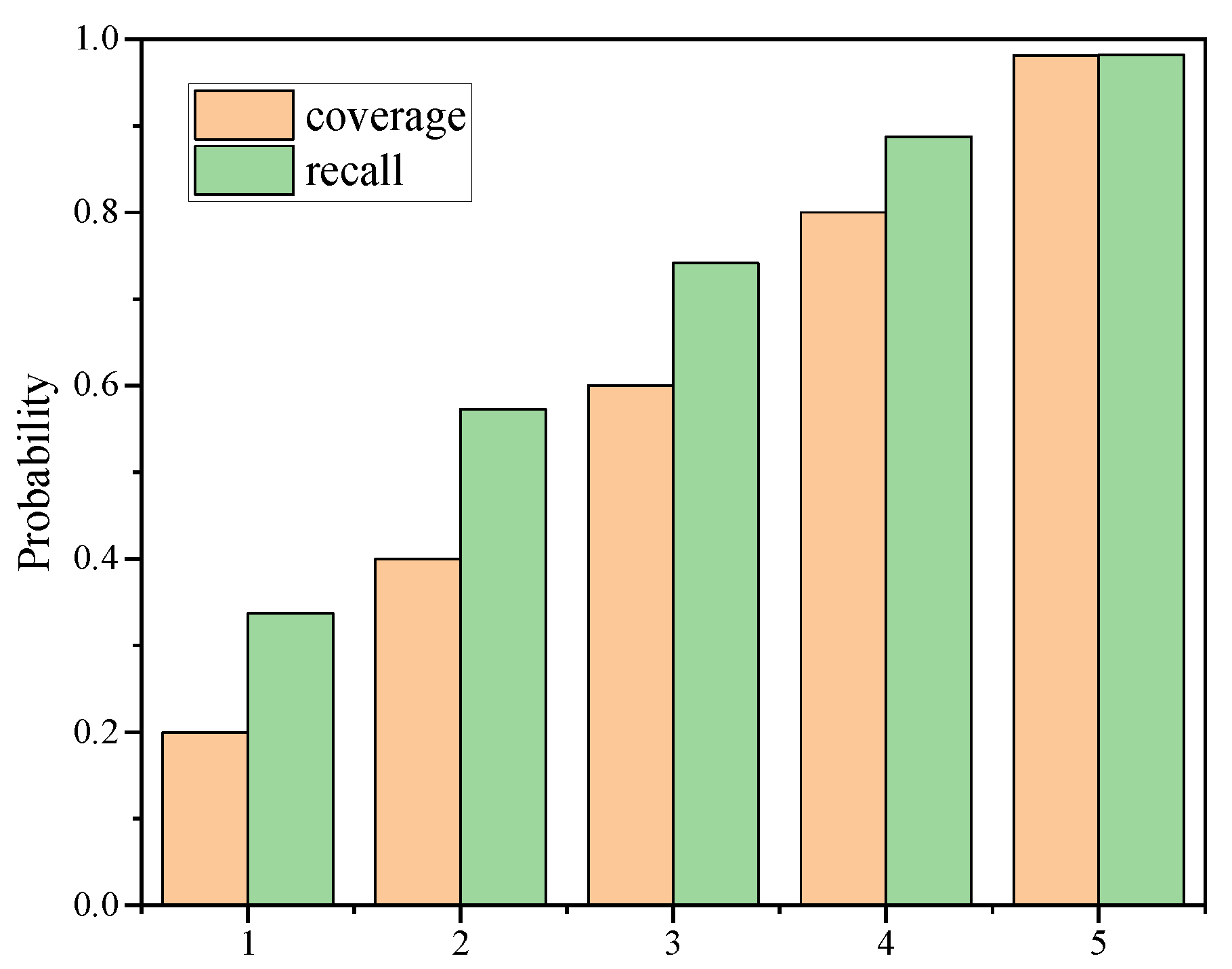

| Index | Field Name | Field Properties | Example |
|---|---|---|---|
| 1 | GantryID | gantry id number | 349E61 |
| 2 | GantryType | gantry type | 2 |
| 3 | TradeTime | gantry trade time | 01/06/2021 08:00:00 |
| 4 | OBUid | vehicle identification | 1775853281 |
| 5 | PassID | itinerary number | 0123…….741 |
Disclaimer/Publisher’s Note: The statements, opinions and data contained in all publications are solely those of the individual author(s) and contributor(s) and not of MDPI and/or the editor(s). MDPI and/or the editor(s) disclaim responsibility for any injury to people or property resulting from any ideas, methods, instructions or products referred to in the content. |
© 2023 by the authors. Licensee MDPI, Basel, Switzerland. This article is an open access article distributed under the terms and conditions of the Creative Commons Attribution (CC BY) license (https://creativecommons.org/licenses/by/4.0/).
Share and Cite
Cai, Q.; Yi, D.; Zou, F.; Wang, W.; Luo, G.; Cai, X. An Arch-Bridge Topology-Based Expressway Network Structure and Automatic Generation. Appl. Sci. 2023, 13, 5031. https://doi.org/10.3390/app13085031
Cai Q, Yi D, Zou F, Wang W, Luo G, Cai X. An Arch-Bridge Topology-Based Expressway Network Structure and Automatic Generation. Applied Sciences. 2023; 13(8):5031. https://doi.org/10.3390/app13085031
Chicago/Turabian StyleCai, Qiqin, Dingrong Yi, Fumin Zou, Weihai Wang, Guanghao Luo, and Xinjian Cai. 2023. "An Arch-Bridge Topology-Based Expressway Network Structure and Automatic Generation" Applied Sciences 13, no. 8: 5031. https://doi.org/10.3390/app13085031
APA StyleCai, Q., Yi, D., Zou, F., Wang, W., Luo, G., & Cai, X. (2023). An Arch-Bridge Topology-Based Expressway Network Structure and Automatic Generation. Applied Sciences, 13(8), 5031. https://doi.org/10.3390/app13085031






